Leadership and Management in Healthcare: A Reflective Report
VerifiedAdded on 2020/10/22
|12
|3258
|69
Report
AI Summary
This report explores leadership and management principles within a healthcare context, utilizing the Gibbs Reflective Cycle to analyze experiences and apply theoretical concepts. The report delves into various management styles, including Fayol's five functions, and their impact on care quality, staff management, and organizational efficiency. It examines the importance of leadership in driving change and facilitating effective decision-making processes, including transactional and transformational leadership styles. The analysis includes an evaluation of management practices, with a focus on improving team effectiveness, communication, and overall service quality within a care home setting. The report concludes with actionable recommendations for improving leadership and management practices, emphasizing the importance of adaptability and employee engagement.
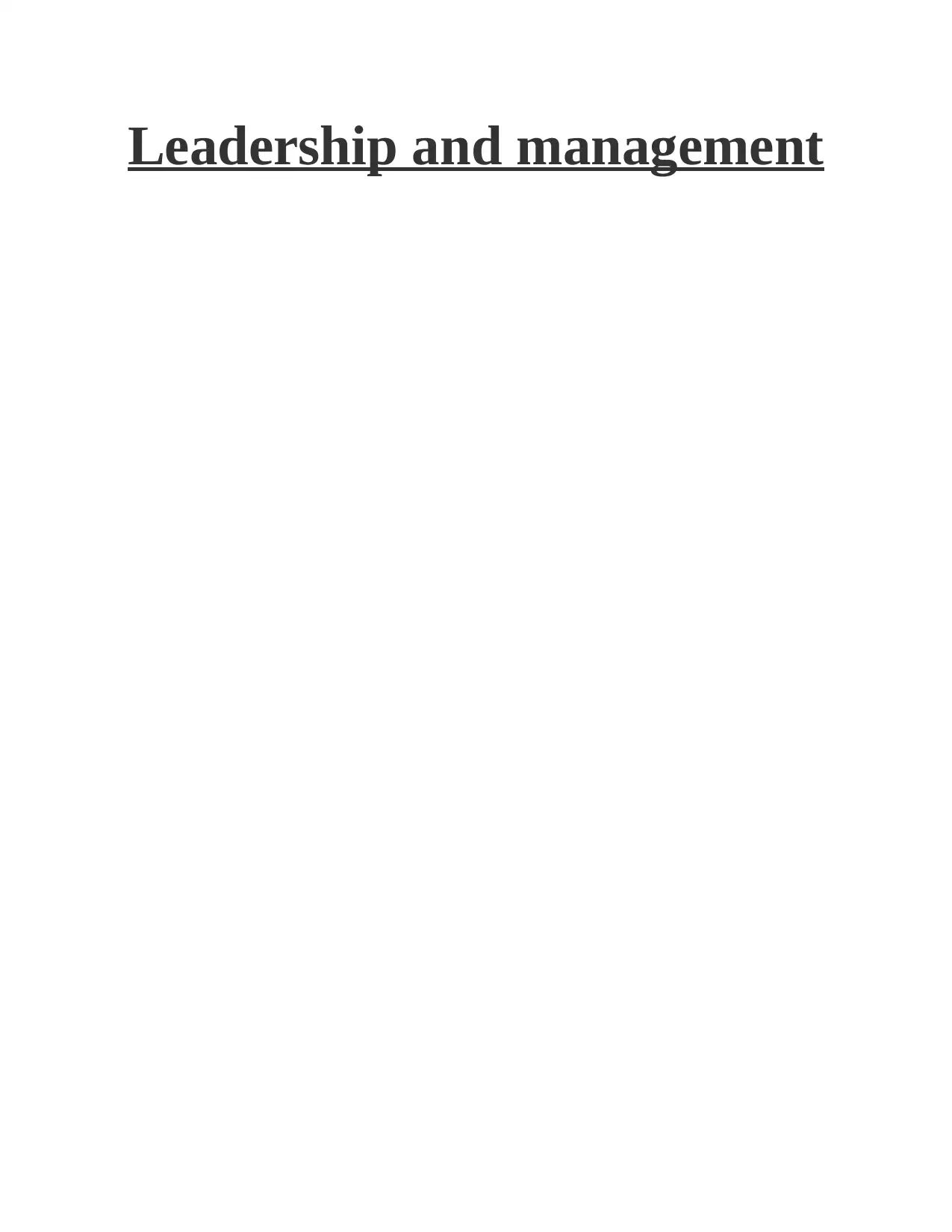
Leadership and management
Paraphrase This Document
Need a fresh take? Get an instant paraphrase of this document with our AI Paraphraser
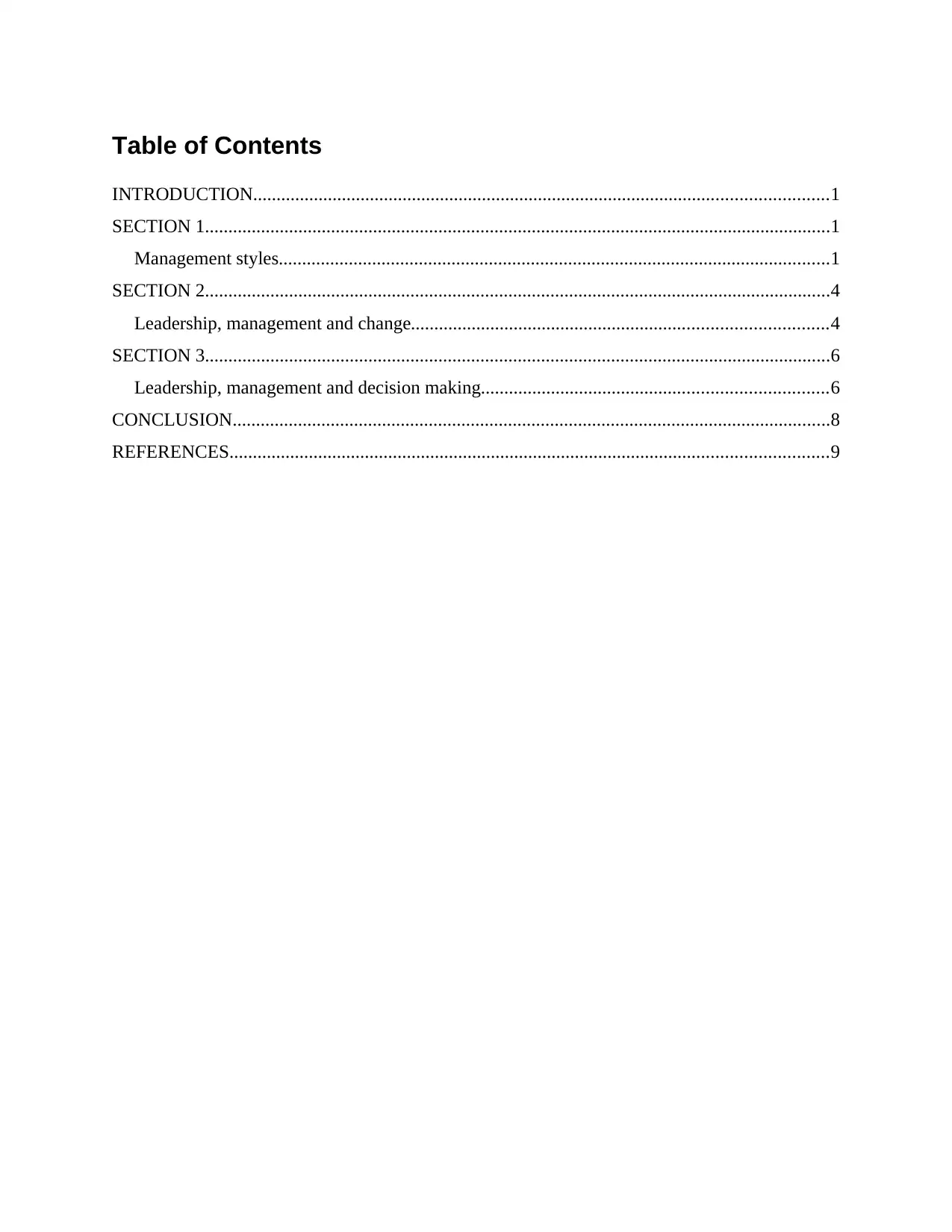
Table of Contents
INTRODUCTION...........................................................................................................................1
SECTION 1......................................................................................................................................1
Management styles......................................................................................................................1
SECTION 2......................................................................................................................................4
Leadership, management and change.........................................................................................4
SECTION 3......................................................................................................................................6
Leadership, management and decision making..........................................................................6
CONCLUSION................................................................................................................................8
REFERENCES................................................................................................................................9
INTRODUCTION...........................................................................................................................1
SECTION 1......................................................................................................................................1
Management styles......................................................................................................................1
SECTION 2......................................................................................................................................4
Leadership, management and change.........................................................................................4
SECTION 3......................................................................................................................................6
Leadership, management and decision making..........................................................................6
CONCLUSION................................................................................................................................8
REFERENCES................................................................................................................................9
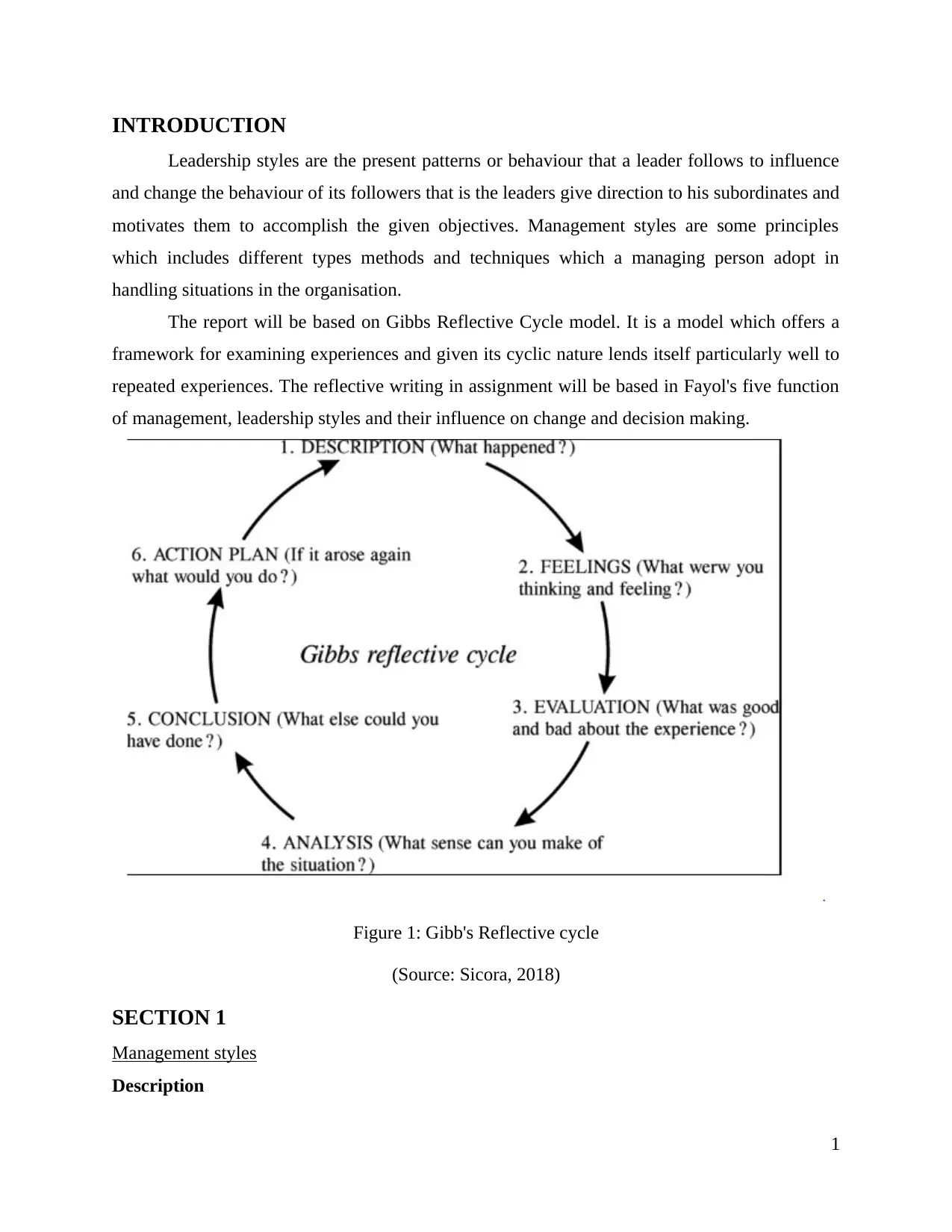
INTRODUCTION
Leadership styles are the present patterns or behaviour that a leader follows to influence
and change the behaviour of its followers that is the leaders give direction to his subordinates and
motivates them to accomplish the given objectives. Management styles are some principles
which includes different types methods and techniques which a managing person adopt in
handling situations in the organisation.
The report will be based on Gibbs Reflective Cycle model. It is a model which offers a
framework for examining experiences and given its cyclic nature lends itself particularly well to
repeated experiences. The reflective writing in assignment will be based in Fayol's five function
of management, leadership styles and their influence on change and decision making.
Figure 1: Gibb's Reflective cycle
(Source: Sicora, 2018)
SECTION 1
Management styles
Description
1
Leadership styles are the present patterns or behaviour that a leader follows to influence
and change the behaviour of its followers that is the leaders give direction to his subordinates and
motivates them to accomplish the given objectives. Management styles are some principles
which includes different types methods and techniques which a managing person adopt in
handling situations in the organisation.
The report will be based on Gibbs Reflective Cycle model. It is a model which offers a
framework for examining experiences and given its cyclic nature lends itself particularly well to
repeated experiences. The reflective writing in assignment will be based in Fayol's five function
of management, leadership styles and their influence on change and decision making.
Figure 1: Gibb's Reflective cycle
(Source: Sicora, 2018)
SECTION 1
Management styles
Description
1
⊘ This is a preview!⊘
Do you want full access?
Subscribe today to unlock all pages.

Trusted by 1+ million students worldwide
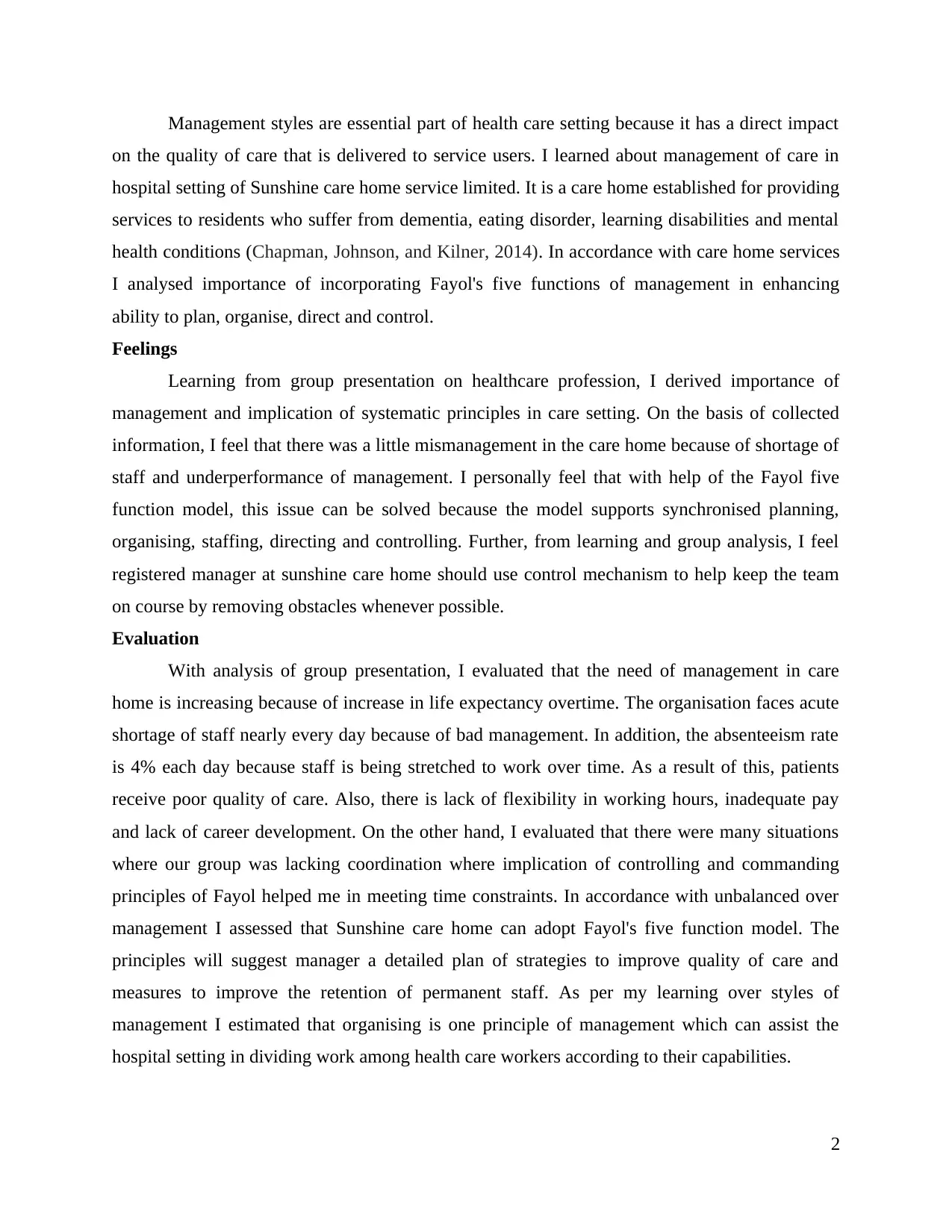
Management styles are essential part of health care setting because it has a direct impact
on the quality of care that is delivered to service users. I learned about management of care in
hospital setting of Sunshine care home service limited. It is a care home established for providing
services to residents who suffer from dementia, eating disorder, learning disabilities and mental
health conditions (Chapman, Johnson, and Kilner, 2014). In accordance with care home services
I analysed importance of incorporating Fayol's five functions of management in enhancing
ability to plan, organise, direct and control.
Feelings
Learning from group presentation on healthcare profession, I derived importance of
management and implication of systematic principles in care setting. On the basis of collected
information, I feel that there was a little mismanagement in the care home because of shortage of
staff and underperformance of management. I personally feel that with help of the Fayol five
function model, this issue can be solved because the model supports synchronised planning,
organising, staffing, directing and controlling. Further, from learning and group analysis, I feel
registered manager at sunshine care home should use control mechanism to help keep the team
on course by removing obstacles whenever possible.
Evaluation
With analysis of group presentation, I evaluated that the need of management in care
home is increasing because of increase in life expectancy overtime. The organisation faces acute
shortage of staff nearly every day because of bad management. In addition, the absenteeism rate
is 4% each day because staff is being stretched to work over time. As a result of this, patients
receive poor quality of care. Also, there is lack of flexibility in working hours, inadequate pay
and lack of career development. On the other hand, I evaluated that there were many situations
where our group was lacking coordination where implication of controlling and commanding
principles of Fayol helped me in meeting time constraints. In accordance with unbalanced over
management I assessed that Sunshine care home can adopt Fayol's five function model. The
principles will suggest manager a detailed plan of strategies to improve quality of care and
measures to improve the retention of permanent staff. As per my learning over styles of
management I estimated that organising is one principle of management which can assist the
hospital setting in dividing work among health care workers according to their capabilities.
2
on the quality of care that is delivered to service users. I learned about management of care in
hospital setting of Sunshine care home service limited. It is a care home established for providing
services to residents who suffer from dementia, eating disorder, learning disabilities and mental
health conditions (Chapman, Johnson, and Kilner, 2014). In accordance with care home services
I analysed importance of incorporating Fayol's five functions of management in enhancing
ability to plan, organise, direct and control.
Feelings
Learning from group presentation on healthcare profession, I derived importance of
management and implication of systematic principles in care setting. On the basis of collected
information, I feel that there was a little mismanagement in the care home because of shortage of
staff and underperformance of management. I personally feel that with help of the Fayol five
function model, this issue can be solved because the model supports synchronised planning,
organising, staffing, directing and controlling. Further, from learning and group analysis, I feel
registered manager at sunshine care home should use control mechanism to help keep the team
on course by removing obstacles whenever possible.
Evaluation
With analysis of group presentation, I evaluated that the need of management in care
home is increasing because of increase in life expectancy overtime. The organisation faces acute
shortage of staff nearly every day because of bad management. In addition, the absenteeism rate
is 4% each day because staff is being stretched to work over time. As a result of this, patients
receive poor quality of care. Also, there is lack of flexibility in working hours, inadequate pay
and lack of career development. On the other hand, I evaluated that there were many situations
where our group was lacking coordination where implication of controlling and commanding
principles of Fayol helped me in meeting time constraints. In accordance with unbalanced over
management I assessed that Sunshine care home can adopt Fayol's five function model. The
principles will suggest manager a detailed plan of strategies to improve quality of care and
measures to improve the retention of permanent staff. As per my learning over styles of
management I estimated that organising is one principle of management which can assist the
hospital setting in dividing work among health care workers according to their capabilities.
2
Paraphrase This Document
Need a fresh take? Get an instant paraphrase of this document with our AI Paraphraser
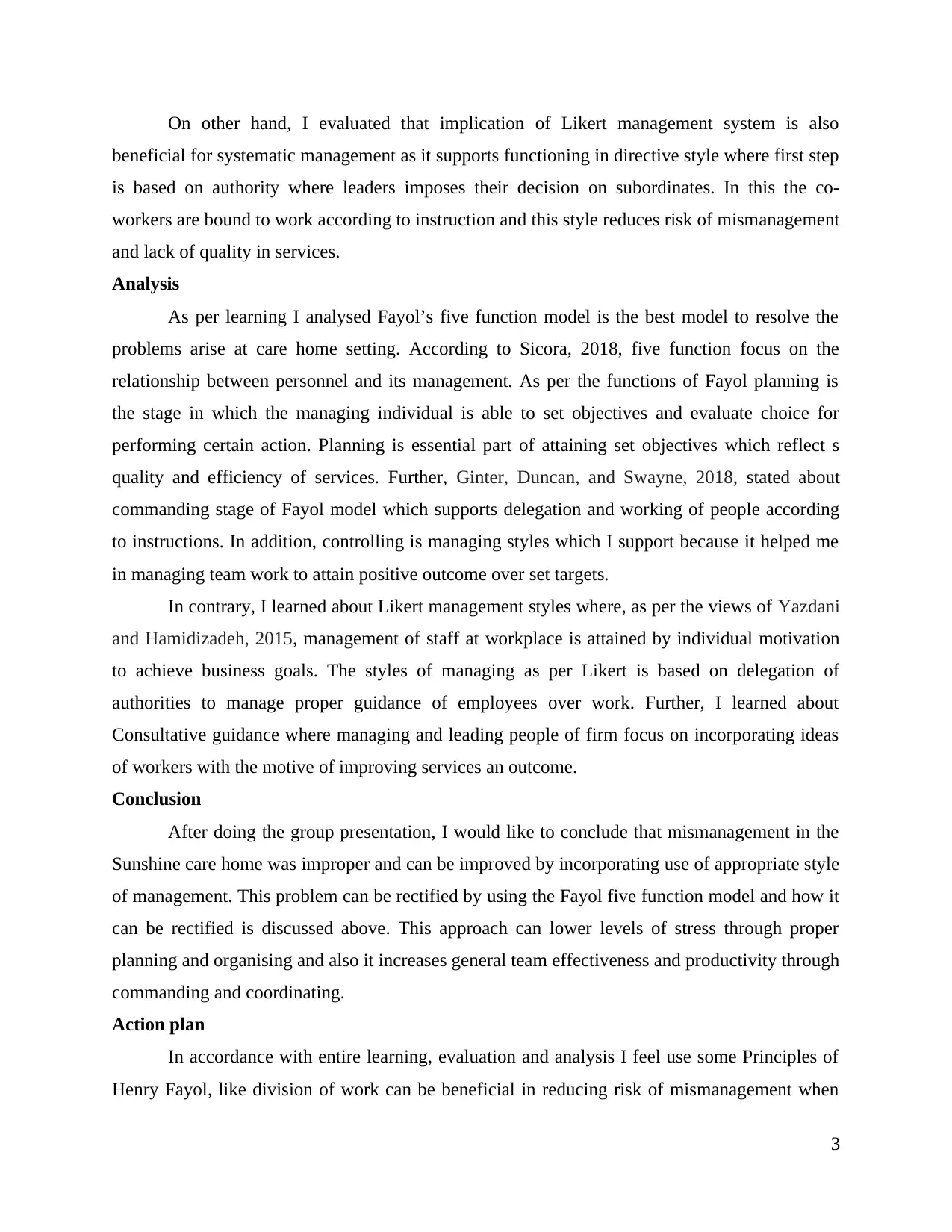
On other hand, I evaluated that implication of Likert management system is also
beneficial for systematic management as it supports functioning in directive style where first step
is based on authority where leaders imposes their decision on subordinates. In this the co-
workers are bound to work according to instruction and this style reduces risk of mismanagement
and lack of quality in services.
Analysis
As per learning I analysed Fayol’s five function model is the best model to resolve the
problems arise at care home setting. According to Sicora, 2018, five function focus on the
relationship between personnel and its management. As per the functions of Fayol planning is
the stage in which the managing individual is able to set objectives and evaluate choice for
performing certain action. Planning is essential part of attaining set objectives which reflect s
quality and efficiency of services. Further, Ginter, Duncan, and Swayne, 2018, stated about
commanding stage of Fayol model which supports delegation and working of people according
to instructions. In addition, controlling is managing styles which I support because it helped me
in managing team work to attain positive outcome over set targets.
In contrary, I learned about Likert management styles where, as per the views of Yazdani
and Hamidizadeh, 2015, management of staff at workplace is attained by individual motivation
to achieve business goals. The styles of managing as per Likert is based on delegation of
authorities to manage proper guidance of employees over work. Further, I learned about
Consultative guidance where managing and leading people of firm focus on incorporating ideas
of workers with the motive of improving services an outcome.
Conclusion
After doing the group presentation, I would like to conclude that mismanagement in the
Sunshine care home was improper and can be improved by incorporating use of appropriate style
of management. This problem can be rectified by using the Fayol five function model and how it
can be rectified is discussed above. This approach can lower levels of stress through proper
planning and organising and also it increases general team effectiveness and productivity through
commanding and coordinating.
Action plan
In accordance with entire learning, evaluation and analysis I feel use some Principles of
Henry Fayol, like division of work can be beneficial in reducing risk of mismanagement when
3
beneficial for systematic management as it supports functioning in directive style where first step
is based on authority where leaders imposes their decision on subordinates. In this the co-
workers are bound to work according to instruction and this style reduces risk of mismanagement
and lack of quality in services.
Analysis
As per learning I analysed Fayol’s five function model is the best model to resolve the
problems arise at care home setting. According to Sicora, 2018, five function focus on the
relationship between personnel and its management. As per the functions of Fayol planning is
the stage in which the managing individual is able to set objectives and evaluate choice for
performing certain action. Planning is essential part of attaining set objectives which reflect s
quality and efficiency of services. Further, Ginter, Duncan, and Swayne, 2018, stated about
commanding stage of Fayol model which supports delegation and working of people according
to instructions. In addition, controlling is managing styles which I support because it helped me
in managing team work to attain positive outcome over set targets.
In contrary, I learned about Likert management styles where, as per the views of Yazdani
and Hamidizadeh, 2015, management of staff at workplace is attained by individual motivation
to achieve business goals. The styles of managing as per Likert is based on delegation of
authorities to manage proper guidance of employees over work. Further, I learned about
Consultative guidance where managing and leading people of firm focus on incorporating ideas
of workers with the motive of improving services an outcome.
Conclusion
After doing the group presentation, I would like to conclude that mismanagement in the
Sunshine care home was improper and can be improved by incorporating use of appropriate style
of management. This problem can be rectified by using the Fayol five function model and how it
can be rectified is discussed above. This approach can lower levels of stress through proper
planning and organising and also it increases general team effectiveness and productivity through
commanding and coordinating.
Action plan
In accordance with entire learning, evaluation and analysis I feel use some Principles of
Henry Fayol, like division of work can be beneficial in reducing risk of mismanagement when
3
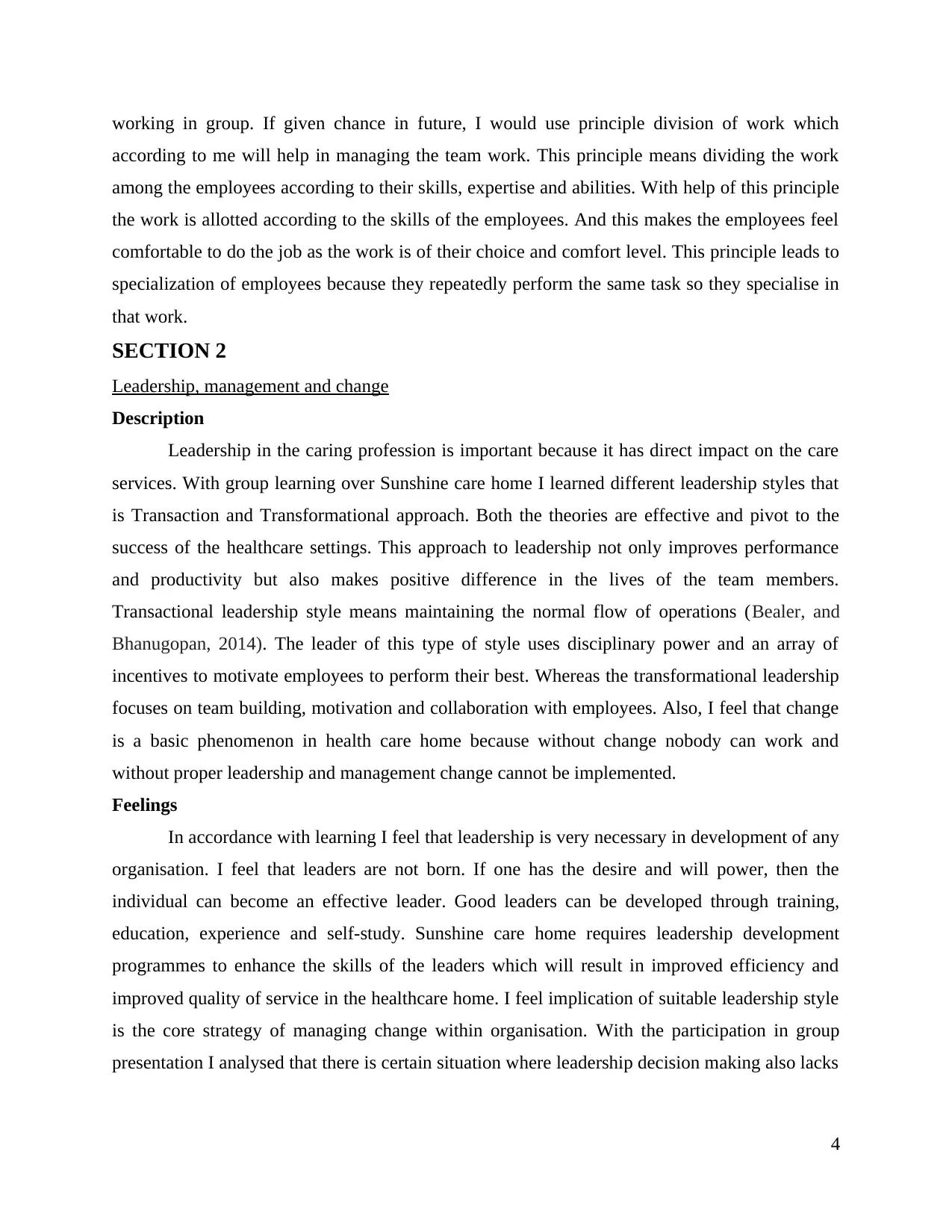
working in group. If given chance in future, I would use principle division of work which
according to me will help in managing the team work. This principle means dividing the work
among the employees according to their skills, expertise and abilities. With help of this principle
the work is allotted according to the skills of the employees. And this makes the employees feel
comfortable to do the job as the work is of their choice and comfort level. This principle leads to
specialization of employees because they repeatedly perform the same task so they specialise in
that work.
SECTION 2
Leadership, management and change
Description
Leadership in the caring profession is important because it has direct impact on the care
services. With group learning over Sunshine care home I learned different leadership styles that
is Transaction and Transformational approach. Both the theories are effective and pivot to the
success of the healthcare settings. This approach to leadership not only improves performance
and productivity but also makes positive difference in the lives of the team members.
Transactional leadership style means maintaining the normal flow of operations (Bealer, and
Bhanugopan, 2014). The leader of this type of style uses disciplinary power and an array of
incentives to motivate employees to perform their best. Whereas the transformational leadership
focuses on team building, motivation and collaboration with employees. Also, I feel that change
is a basic phenomenon in health care home because without change nobody can work and
without proper leadership and management change cannot be implemented.
Feelings
In accordance with learning I feel that leadership is very necessary in development of any
organisation. I feel that leaders are not born. If one has the desire and will power, then the
individual can become an effective leader. Good leaders can be developed through training,
education, experience and self-study. Sunshine care home requires leadership development
programmes to enhance the skills of the leaders which will result in improved efficiency and
improved quality of service in the healthcare home. I feel implication of suitable leadership style
is the core strategy of managing change within organisation. With the participation in group
presentation I analysed that there is certain situation where leadership decision making also lacks
4
according to me will help in managing the team work. This principle means dividing the work
among the employees according to their skills, expertise and abilities. With help of this principle
the work is allotted according to the skills of the employees. And this makes the employees feel
comfortable to do the job as the work is of their choice and comfort level. This principle leads to
specialization of employees because they repeatedly perform the same task so they specialise in
that work.
SECTION 2
Leadership, management and change
Description
Leadership in the caring profession is important because it has direct impact on the care
services. With group learning over Sunshine care home I learned different leadership styles that
is Transaction and Transformational approach. Both the theories are effective and pivot to the
success of the healthcare settings. This approach to leadership not only improves performance
and productivity but also makes positive difference in the lives of the team members.
Transactional leadership style means maintaining the normal flow of operations (Bealer, and
Bhanugopan, 2014). The leader of this type of style uses disciplinary power and an array of
incentives to motivate employees to perform their best. Whereas the transformational leadership
focuses on team building, motivation and collaboration with employees. Also, I feel that change
is a basic phenomenon in health care home because without change nobody can work and
without proper leadership and management change cannot be implemented.
Feelings
In accordance with learning I feel that leadership is very necessary in development of any
organisation. I feel that leaders are not born. If one has the desire and will power, then the
individual can become an effective leader. Good leaders can be developed through training,
education, experience and self-study. Sunshine care home requires leadership development
programmes to enhance the skills of the leaders which will result in improved efficiency and
improved quality of service in the healthcare home. I feel implication of suitable leadership style
is the core strategy of managing change within organisation. With the participation in group
presentation I analysed that there is certain situation where leadership decision making also lacks
4
⊘ This is a preview!⊘
Do you want full access?
Subscribe today to unlock all pages.

Trusted by 1+ million students worldwide
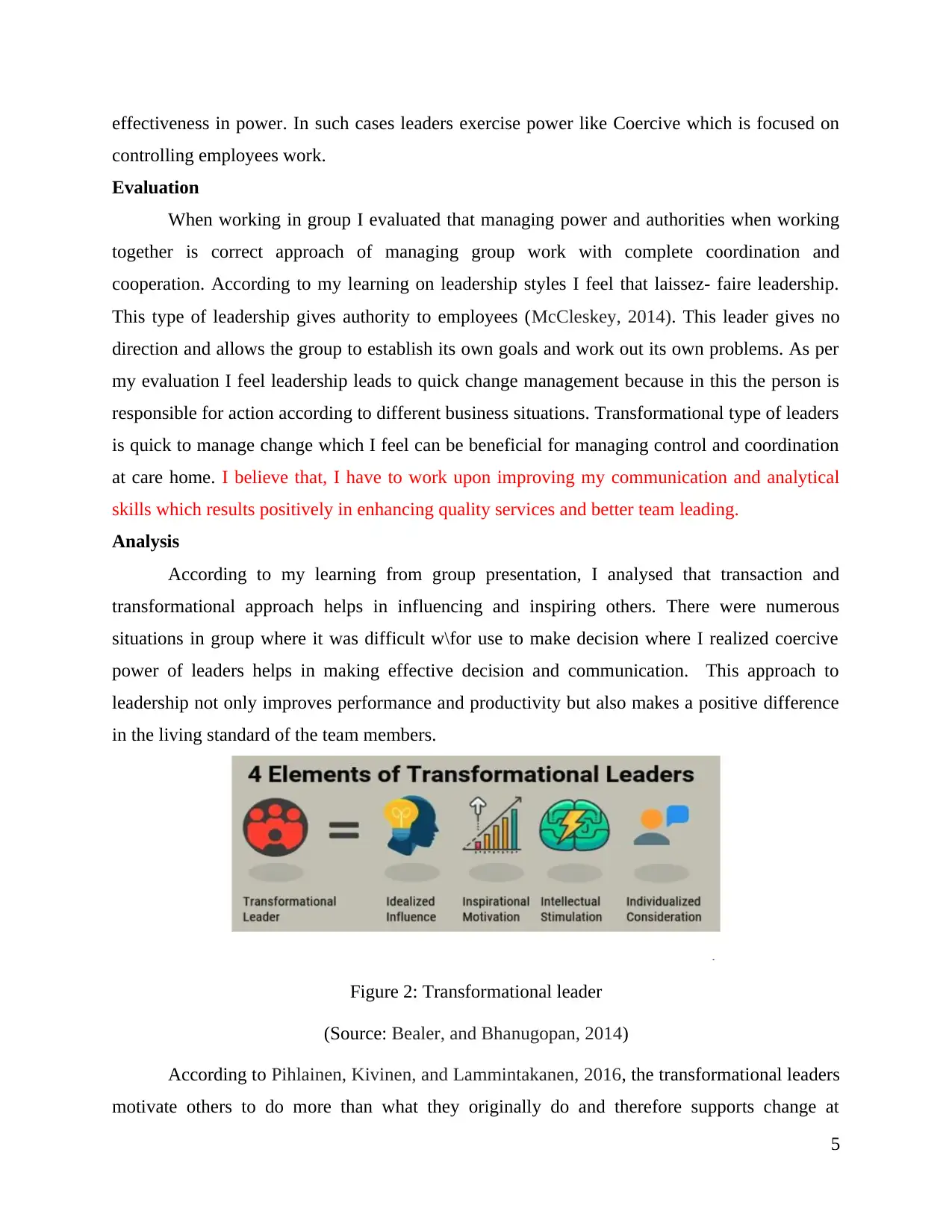
effectiveness in power. In such cases leaders exercise power like Coercive which is focused on
controlling employees work.
Evaluation
When working in group I evaluated that managing power and authorities when working
together is correct approach of managing group work with complete coordination and
cooperation. According to my learning on leadership styles I feel that laissez- faire leadership.
This type of leadership gives authority to employees (McCleskey, 2014). This leader gives no
direction and allows the group to establish its own goals and work out its own problems. As per
my evaluation I feel leadership leads to quick change management because in this the person is
responsible for action according to different business situations. Transformational type of leaders
is quick to manage change which I feel can be beneficial for managing control and coordination
at care home. I believe that, I have to work upon improving my communication and analytical
skills which results positively in enhancing quality services and better team leading.
Analysis
According to my learning from group presentation, I analysed that transaction and
transformational approach helps in influencing and inspiring others. There were numerous
situations in group where it was difficult w\for use to make decision where I realized coercive
power of leaders helps in making effective decision and communication. This approach to
leadership not only improves performance and productivity but also makes a positive difference
in the living standard of the team members.
Figure 2: Transformational leader
(Source: Bealer, and Bhanugopan, 2014)
According to Pihlainen, Kivinen, and Lammintakanen, 2016, the transformational leaders
motivate others to do more than what they originally do and therefore supports change at
5
controlling employees work.
Evaluation
When working in group I evaluated that managing power and authorities when working
together is correct approach of managing group work with complete coordination and
cooperation. According to my learning on leadership styles I feel that laissez- faire leadership.
This type of leadership gives authority to employees (McCleskey, 2014). This leader gives no
direction and allows the group to establish its own goals and work out its own problems. As per
my evaluation I feel leadership leads to quick change management because in this the person is
responsible for action according to different business situations. Transformational type of leaders
is quick to manage change which I feel can be beneficial for managing control and coordination
at care home. I believe that, I have to work upon improving my communication and analytical
skills which results positively in enhancing quality services and better team leading.
Analysis
According to my learning from group presentation, I analysed that transaction and
transformational approach helps in influencing and inspiring others. There were numerous
situations in group where it was difficult w\for use to make decision where I realized coercive
power of leaders helps in making effective decision and communication. This approach to
leadership not only improves performance and productivity but also makes a positive difference
in the living standard of the team members.
Figure 2: Transformational leader
(Source: Bealer, and Bhanugopan, 2014)
According to Pihlainen, Kivinen, and Lammintakanen, 2016, the transformational leaders
motivate others to do more than what they originally do and therefore supports change at
5
Paraphrase This Document
Need a fresh take? Get an instant paraphrase of this document with our AI Paraphraser
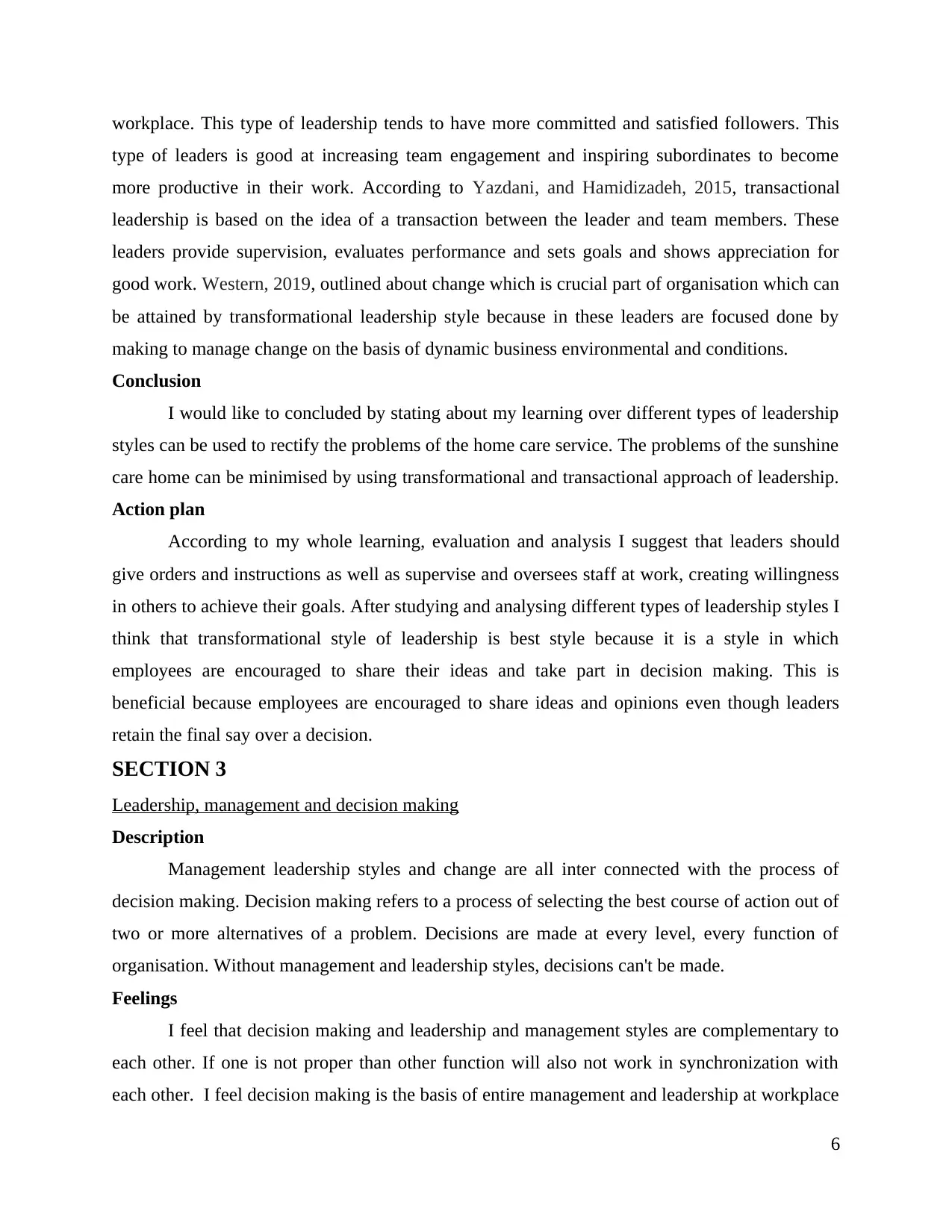
workplace. This type of leadership tends to have more committed and satisfied followers. This
type of leaders is good at increasing team engagement and inspiring subordinates to become
more productive in their work. According to Yazdani, and Hamidizadeh, 2015, transactional
leadership is based on the idea of a transaction between the leader and team members. These
leaders provide supervision, evaluates performance and sets goals and shows appreciation for
good work. Western, 2019, outlined about change which is crucial part of organisation which can
be attained by transformational leadership style because in these leaders are focused done by
making to manage change on the basis of dynamic business environmental and conditions.
Conclusion
I would like to concluded by stating about my learning over different types of leadership
styles can be used to rectify the problems of the home care service. The problems of the sunshine
care home can be minimised by using transformational and transactional approach of leadership.
Action plan
According to my whole learning, evaluation and analysis I suggest that leaders should
give orders and instructions as well as supervise and oversees staff at work, creating willingness
in others to achieve their goals. After studying and analysing different types of leadership styles I
think that transformational style of leadership is best style because it is a style in which
employees are encouraged to share their ideas and take part in decision making. This is
beneficial because employees are encouraged to share ideas and opinions even though leaders
retain the final say over a decision.
SECTION 3
Leadership, management and decision making
Description
Management leadership styles and change are all inter connected with the process of
decision making. Decision making refers to a process of selecting the best course of action out of
two or more alternatives of a problem. Decisions are made at every level, every function of
organisation. Without management and leadership styles, decisions can't be made.
Feelings
I feel that decision making and leadership and management styles are complementary to
each other. If one is not proper than other function will also not work in synchronization with
each other. I feel decision making is the basis of entire management and leadership at workplace
6
type of leaders is good at increasing team engagement and inspiring subordinates to become
more productive in their work. According to Yazdani, and Hamidizadeh, 2015, transactional
leadership is based on the idea of a transaction between the leader and team members. These
leaders provide supervision, evaluates performance and sets goals and shows appreciation for
good work. Western, 2019, outlined about change which is crucial part of organisation which can
be attained by transformational leadership style because in these leaders are focused done by
making to manage change on the basis of dynamic business environmental and conditions.
Conclusion
I would like to concluded by stating about my learning over different types of leadership
styles can be used to rectify the problems of the home care service. The problems of the sunshine
care home can be minimised by using transformational and transactional approach of leadership.
Action plan
According to my whole learning, evaluation and analysis I suggest that leaders should
give orders and instructions as well as supervise and oversees staff at work, creating willingness
in others to achieve their goals. After studying and analysing different types of leadership styles I
think that transformational style of leadership is best style because it is a style in which
employees are encouraged to share their ideas and take part in decision making. This is
beneficial because employees are encouraged to share ideas and opinions even though leaders
retain the final say over a decision.
SECTION 3
Leadership, management and decision making
Description
Management leadership styles and change are all inter connected with the process of
decision making. Decision making refers to a process of selecting the best course of action out of
two or more alternatives of a problem. Decisions are made at every level, every function of
organisation. Without management and leadership styles, decisions can't be made.
Feelings
I feel that decision making and leadership and management styles are complementary to
each other. If one is not proper than other function will also not work in synchronization with
each other. I feel decision making is the basis of entire management and leadership at workplace
6
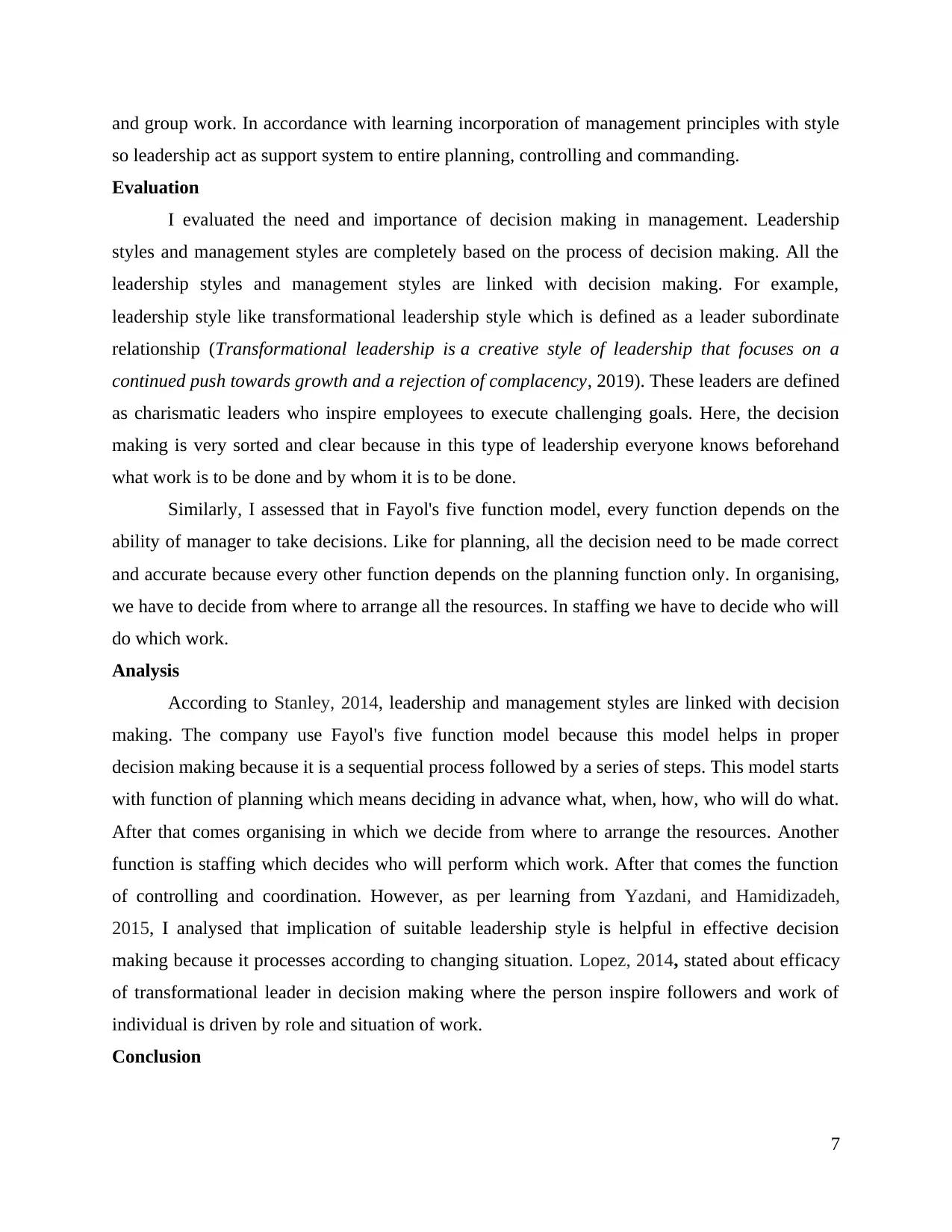
and group work. In accordance with learning incorporation of management principles with style
so leadership act as support system to entire planning, controlling and commanding.
Evaluation
I evaluated the need and importance of decision making in management. Leadership
styles and management styles are completely based on the process of decision making. All the
leadership styles and management styles are linked with decision making. For example,
leadership style like transformational leadership style which is defined as a leader subordinate
relationship (Transformational leadership is a creative style of leadership that focuses on a
continued push towards growth and a rejection of complacency, 2019). These leaders are defined
as charismatic leaders who inspire employees to execute challenging goals. Here, the decision
making is very sorted and clear because in this type of leadership everyone knows beforehand
what work is to be done and by whom it is to be done.
Similarly, I assessed that in Fayol's five function model, every function depends on the
ability of manager to take decisions. Like for planning, all the decision need to be made correct
and accurate because every other function depends on the planning function only. In organising,
we have to decide from where to arrange all the resources. In staffing we have to decide who will
do which work.
Analysis
According to Stanley, 2014, leadership and management styles are linked with decision
making. The company use Fayol's five function model because this model helps in proper
decision making because it is a sequential process followed by a series of steps. This model starts
with function of planning which means deciding in advance what, when, how, who will do what.
After that comes organising in which we decide from where to arrange the resources. Another
function is staffing which decides who will perform which work. After that comes the function
of controlling and coordination. However, as per learning from Yazdani, and Hamidizadeh,
2015, I analysed that implication of suitable leadership style is helpful in effective decision
making because it processes according to changing situation. Lopez, 2014, stated about efficacy
of transformational leader in decision making where the person inspire followers and work of
individual is driven by role and situation of work.
Conclusion
7
so leadership act as support system to entire planning, controlling and commanding.
Evaluation
I evaluated the need and importance of decision making in management. Leadership
styles and management styles are completely based on the process of decision making. All the
leadership styles and management styles are linked with decision making. For example,
leadership style like transformational leadership style which is defined as a leader subordinate
relationship (Transformational leadership is a creative style of leadership that focuses on a
continued push towards growth and a rejection of complacency, 2019). These leaders are defined
as charismatic leaders who inspire employees to execute challenging goals. Here, the decision
making is very sorted and clear because in this type of leadership everyone knows beforehand
what work is to be done and by whom it is to be done.
Similarly, I assessed that in Fayol's five function model, every function depends on the
ability of manager to take decisions. Like for planning, all the decision need to be made correct
and accurate because every other function depends on the planning function only. In organising,
we have to decide from where to arrange all the resources. In staffing we have to decide who will
do which work.
Analysis
According to Stanley, 2014, leadership and management styles are linked with decision
making. The company use Fayol's five function model because this model helps in proper
decision making because it is a sequential process followed by a series of steps. This model starts
with function of planning which means deciding in advance what, when, how, who will do what.
After that comes organising in which we decide from where to arrange the resources. Another
function is staffing which decides who will perform which work. After that comes the function
of controlling and coordination. However, as per learning from Yazdani, and Hamidizadeh,
2015, I analysed that implication of suitable leadership style is helpful in effective decision
making because it processes according to changing situation. Lopez, 2014, stated about efficacy
of transformational leader in decision making where the person inspire followers and work of
individual is driven by role and situation of work.
Conclusion
7
⊘ This is a preview!⊘
Do you want full access?
Subscribe today to unlock all pages.

Trusted by 1+ million students worldwide
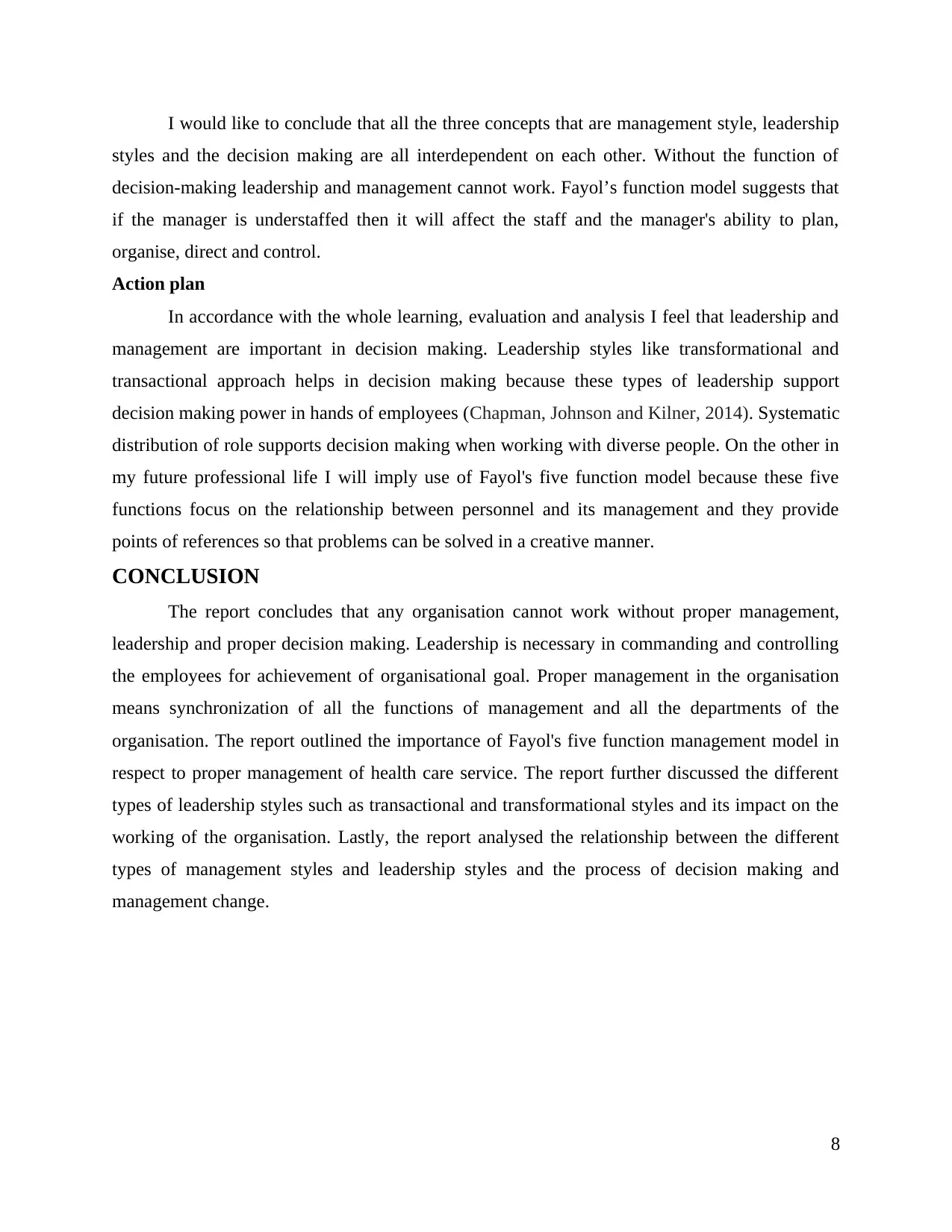
I would like to conclude that all the three concepts that are management style, leadership
styles and the decision making are all interdependent on each other. Without the function of
decision-making leadership and management cannot work. Fayol’s function model suggests that
if the manager is understaffed then it will affect the staff and the manager's ability to plan,
organise, direct and control.
Action plan
In accordance with the whole learning, evaluation and analysis I feel that leadership and
management are important in decision making. Leadership styles like transformational and
transactional approach helps in decision making because these types of leadership support
decision making power in hands of employees (Chapman, Johnson and Kilner, 2014). Systematic
distribution of role supports decision making when working with diverse people. On the other in
my future professional life I will imply use of Fayol's five function model because these five
functions focus on the relationship between personnel and its management and they provide
points of references so that problems can be solved in a creative manner.
CONCLUSION
The report concludes that any organisation cannot work without proper management,
leadership and proper decision making. Leadership is necessary in commanding and controlling
the employees for achievement of organisational goal. Proper management in the organisation
means synchronization of all the functions of management and all the departments of the
organisation. The report outlined the importance of Fayol's five function management model in
respect to proper management of health care service. The report further discussed the different
types of leadership styles such as transactional and transformational styles and its impact on the
working of the organisation. Lastly, the report analysed the relationship between the different
types of management styles and leadership styles and the process of decision making and
management change.
8
styles and the decision making are all interdependent on each other. Without the function of
decision-making leadership and management cannot work. Fayol’s function model suggests that
if the manager is understaffed then it will affect the staff and the manager's ability to plan,
organise, direct and control.
Action plan
In accordance with the whole learning, evaluation and analysis I feel that leadership and
management are important in decision making. Leadership styles like transformational and
transactional approach helps in decision making because these types of leadership support
decision making power in hands of employees (Chapman, Johnson and Kilner, 2014). Systematic
distribution of role supports decision making when working with diverse people. On the other in
my future professional life I will imply use of Fayol's five function model because these five
functions focus on the relationship between personnel and its management and they provide
points of references so that problems can be solved in a creative manner.
CONCLUSION
The report concludes that any organisation cannot work without proper management,
leadership and proper decision making. Leadership is necessary in commanding and controlling
the employees for achievement of organisational goal. Proper management in the organisation
means synchronization of all the functions of management and all the departments of the
organisation. The report outlined the importance of Fayol's five function management model in
respect to proper management of health care service. The report further discussed the different
types of leadership styles such as transactional and transformational styles and its impact on the
working of the organisation. Lastly, the report analysed the relationship between the different
types of management styles and leadership styles and the process of decision making and
management change.
8
Paraphrase This Document
Need a fresh take? Get an instant paraphrase of this document with our AI Paraphraser
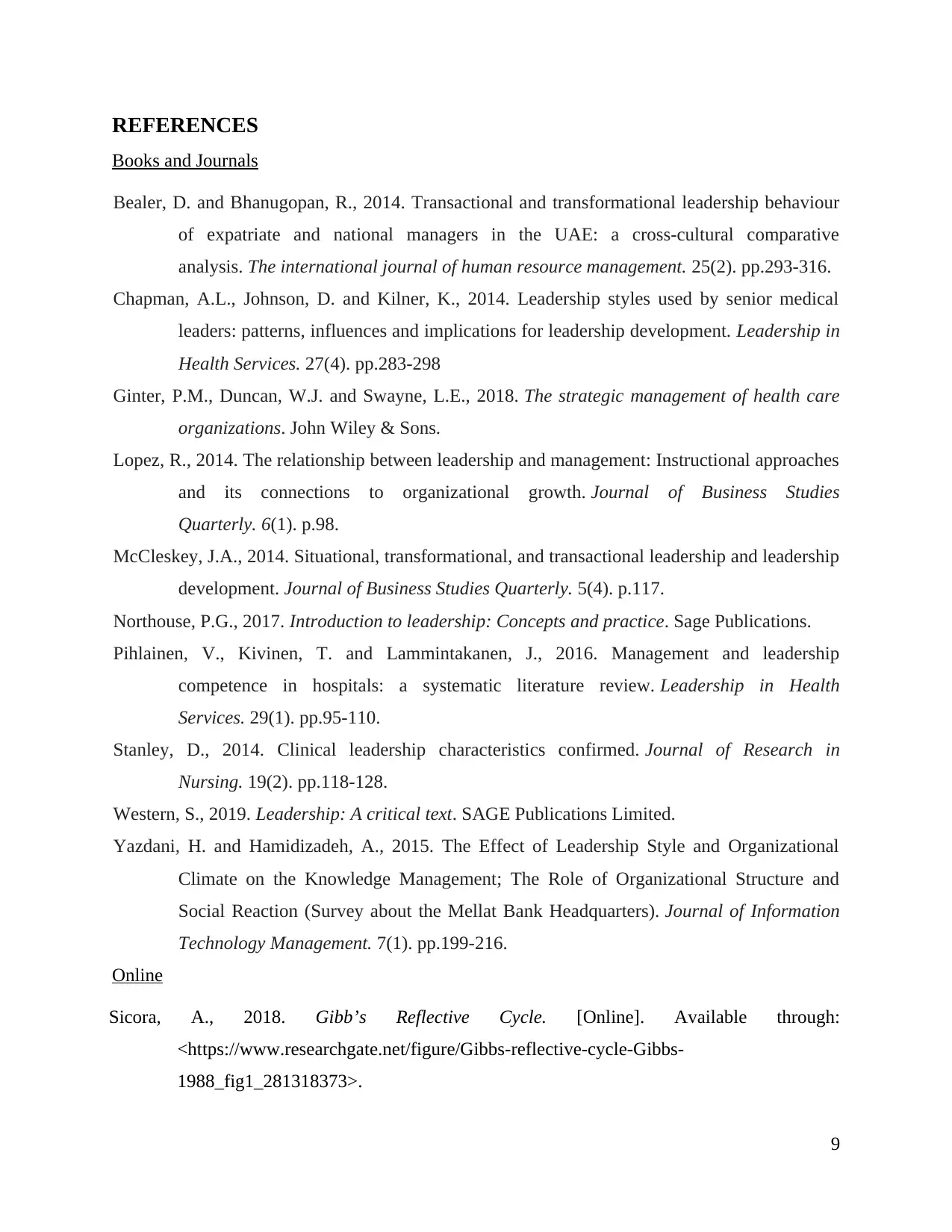
REFERENCES
Books and Journals
Bealer, D. and Bhanugopan, R., 2014. Transactional and transformational leadership behaviour
of expatriate and national managers in the UAE: a cross-cultural comparative
analysis. The international journal of human resource management. 25(2). pp.293-316.
Chapman, A.L., Johnson, D. and Kilner, K., 2014. Leadership styles used by senior medical
leaders: patterns, influences and implications for leadership development. Leadership in
Health Services. 27(4). pp.283-298
Ginter, P.M., Duncan, W.J. and Swayne, L.E., 2018. The strategic management of health care
organizations. John Wiley & Sons.
Lopez, R., 2014. The relationship between leadership and management: Instructional approaches
and its connections to organizational growth. Journal of Business Studies
Quarterly. 6(1). p.98.
McCleskey, J.A., 2014. Situational, transformational, and transactional leadership and leadership
development. Journal of Business Studies Quarterly. 5(4). p.117.
Northouse, P.G., 2017. Introduction to leadership: Concepts and practice. Sage Publications.
Pihlainen, V., Kivinen, T. and Lammintakanen, J., 2016. Management and leadership
competence in hospitals: a systematic literature review. Leadership in Health
Services. 29(1). pp.95-110.
Stanley, D., 2014. Clinical leadership characteristics confirmed. Journal of Research in
Nursing. 19(2). pp.118-128.
Western, S., 2019. Leadership: A critical text. SAGE Publications Limited.
Yazdani, H. and Hamidizadeh, A., 2015. The Effect of Leadership Style and Organizational
Climate on the Knowledge Management; The Role of Organizational Structure and
Social Reaction (Survey about the Mellat Bank Headquarters). Journal of Information
Technology Management. 7(1). pp.199-216.
Online
Sicora, A., 2018. Gibb’s Reflective Cycle. [Online]. Available through:
<https://www.researchgate.net/figure/Gibbs-reflective-cycle-Gibbs-
1988_fig1_281318373>.
9
Books and Journals
Bealer, D. and Bhanugopan, R., 2014. Transactional and transformational leadership behaviour
of expatriate and national managers in the UAE: a cross-cultural comparative
analysis. The international journal of human resource management. 25(2). pp.293-316.
Chapman, A.L., Johnson, D. and Kilner, K., 2014. Leadership styles used by senior medical
leaders: patterns, influences and implications for leadership development. Leadership in
Health Services. 27(4). pp.283-298
Ginter, P.M., Duncan, W.J. and Swayne, L.E., 2018. The strategic management of health care
organizations. John Wiley & Sons.
Lopez, R., 2014. The relationship between leadership and management: Instructional approaches
and its connections to organizational growth. Journal of Business Studies
Quarterly. 6(1). p.98.
McCleskey, J.A., 2014. Situational, transformational, and transactional leadership and leadership
development. Journal of Business Studies Quarterly. 5(4). p.117.
Northouse, P.G., 2017. Introduction to leadership: Concepts and practice. Sage Publications.
Pihlainen, V., Kivinen, T. and Lammintakanen, J., 2016. Management and leadership
competence in hospitals: a systematic literature review. Leadership in Health
Services. 29(1). pp.95-110.
Stanley, D., 2014. Clinical leadership characteristics confirmed. Journal of Research in
Nursing. 19(2). pp.118-128.
Western, S., 2019. Leadership: A critical text. SAGE Publications Limited.
Yazdani, H. and Hamidizadeh, A., 2015. The Effect of Leadership Style and Organizational
Climate on the Knowledge Management; The Role of Organizational Structure and
Social Reaction (Survey about the Mellat Bank Headquarters). Journal of Information
Technology Management. 7(1). pp.199-216.
Online
Sicora, A., 2018. Gibb’s Reflective Cycle. [Online]. Available through:
<https://www.researchgate.net/figure/Gibbs-reflective-cycle-Gibbs-
1988_fig1_281318373>.
9
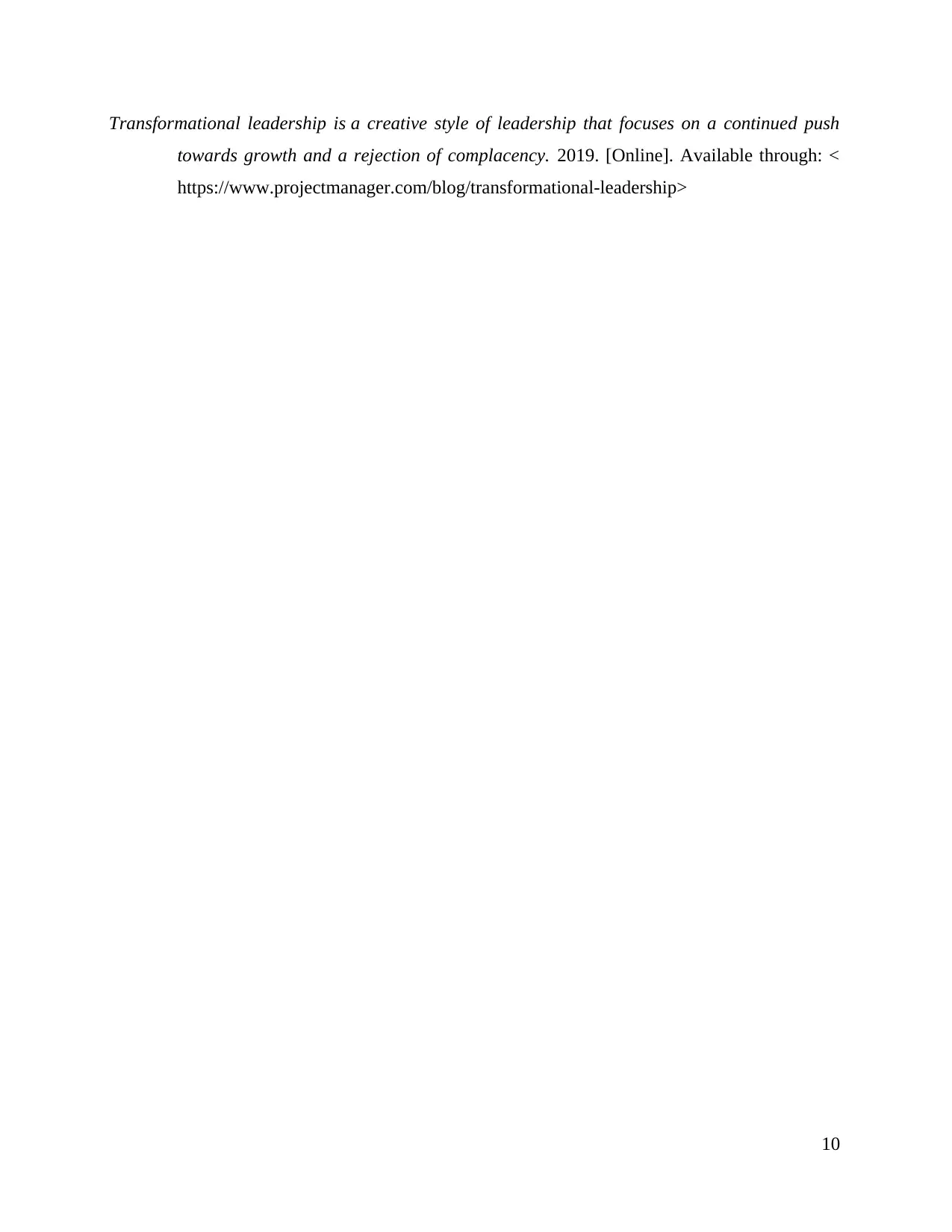
Transformational leadership is a creative style of leadership that focuses on a continued push
towards growth and a rejection of complacency. 2019. [Online]. Available through: <
https://www.projectmanager.com/blog/transformational-leadership>
10
towards growth and a rejection of complacency. 2019. [Online]. Available through: <
https://www.projectmanager.com/blog/transformational-leadership>
10
⊘ This is a preview!⊘
Do you want full access?
Subscribe today to unlock all pages.

Trusted by 1+ million students worldwide
1 out of 12
Related Documents
Your All-in-One AI-Powered Toolkit for Academic Success.
+13062052269
info@desklib.com
Available 24*7 on WhatsApp / Email
![[object Object]](/_next/static/media/star-bottom.7253800d.svg)
Unlock your academic potential
Copyright © 2020–2025 A2Z Services. All Rights Reserved. Developed and managed by ZUCOL.




